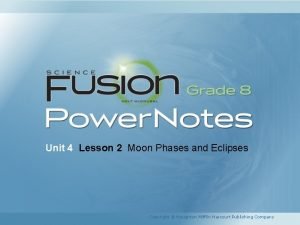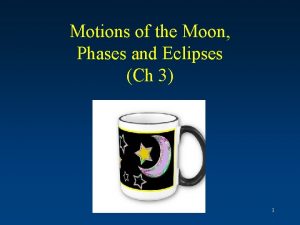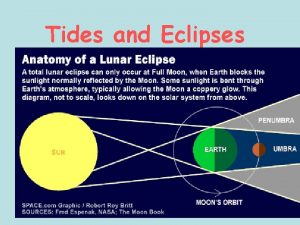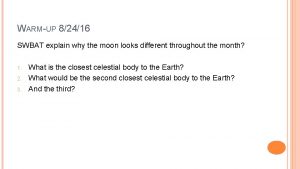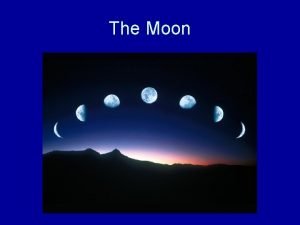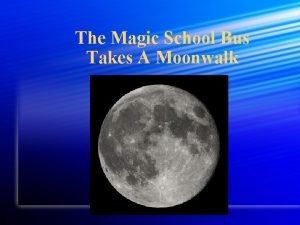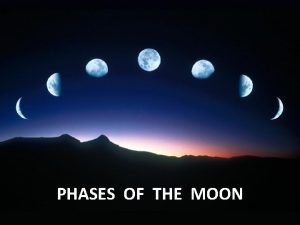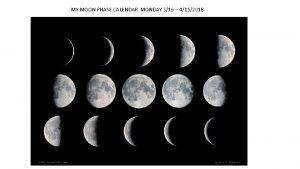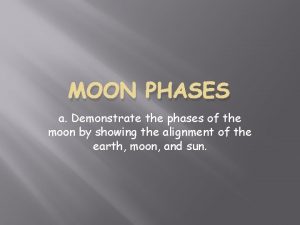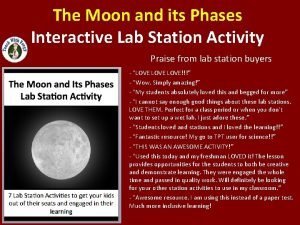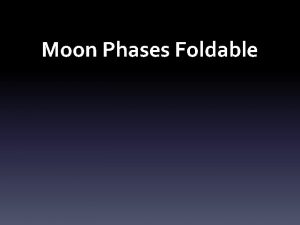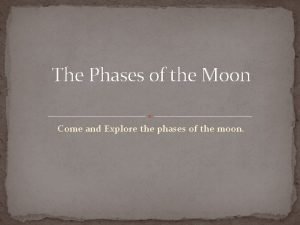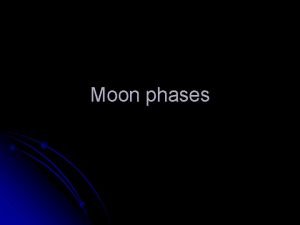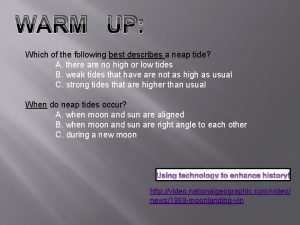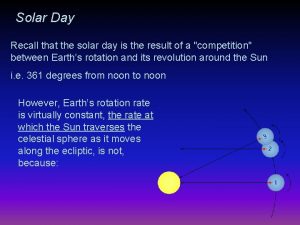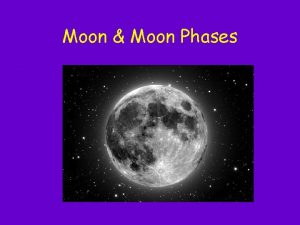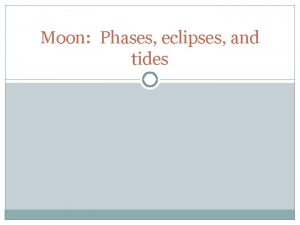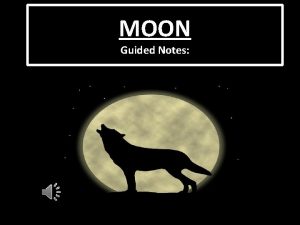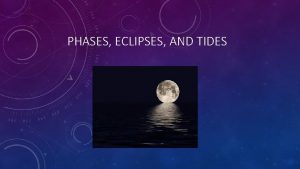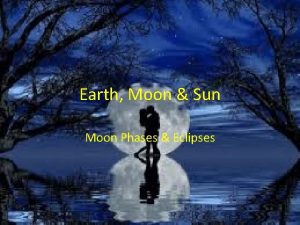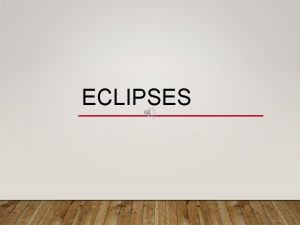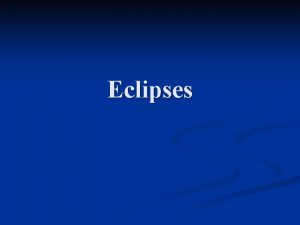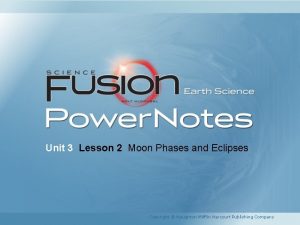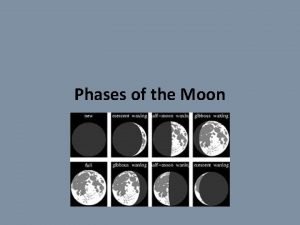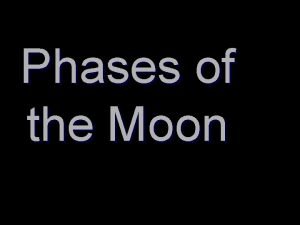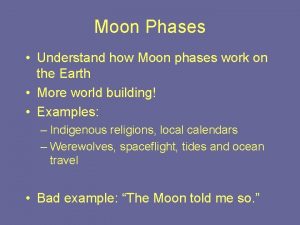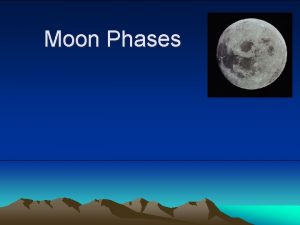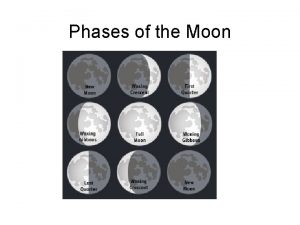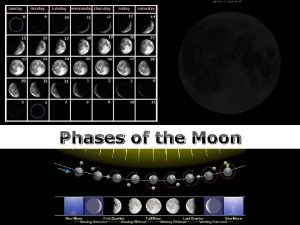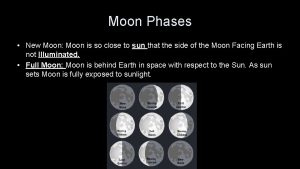Unit 4 Lesson 2 Moon Phases and Eclipses





















- Slides: 21

Unit 4 Lesson 2 Moon Phases and Eclipses Copyright © Houghton Mifflin Harcourt Publishing Company

Unit 4 Lesson 2 Moon Phases and Eclipses Florida Benchmark • SC. 8. E. 5. 9 Explain the impact of objects in space on each other including: 1. The Sun on the Earth including seasons and gravitational attraction, 2. The Moon on the Earth, including phases, tides, and eclipses, and the relative position of each body. Copyright © Houghton Mifflin Harcourt Publishing Company

Unit 4 Lesson 2 Moon Phases and Eclipses Round and Round They Go! How are Earth, the moon, and the sun related in space? • Earth spins on its axis and orbits around the sun. • A body that orbits a larger body is called a satellite. • Smaller bodies that travel around planets are natural satellites called moons. Copyright © Houghton Mifflin Harcourt Publishing Company

Unit 4 Lesson 2 Moon Phases and Eclipses How are Earth, the moon, and the sun related in space? • Gravity is the force that pulls all bodies that have mass toward other objects. • Earth’s gravitational pull on the moon keeps the moon in orbit, forming the Earth-moon system. • The distance between Earth and the moon is roughly 383, 000 km (238, 000 mi). Copyright © Houghton Mifflin Harcourt Publishing Company

Unit 4 Lesson 2 Moon Phases and Eclipses What does the moon look like from Earth? • The moon is only visible from Earth when it reflects sunlight. • Only one side of the moon, often called the near side, faces Earth. • The moon rotates once on its axis for every 28. 5 days it takes to revolve around Earth. Copyright © Houghton Mifflin Harcourt Publishing Company

Unit 4 Lesson 2 Moon Phases and Eclipses What does the moon look like from Earth? • Why do you always see the same side of the moon? Copyright © Houghton Mifflin Harcourt Publishing Company

Unit 4 Lesson 2 Moon Phases and Eclipses It’s Just a Phase! How does the appearance of the moon change? • As the moon revolves around Earth, the portion of the moon that reflects sunlight back to Earth changes. • The lunar phases are changes in the moon’s appearance due to its position in orbit around Earth. Copyright © Houghton Mifflin Harcourt Publishing Company

Unit 4 Lesson 2 Moon Phases and Eclipses How does the appearance of the moon change? • Lunar phases cycle monthly and begin with a new moon. • The new moon is hard to see because Earth, the moon, and the sun are lined up, making the moon unlit. • As the moon moves in its orbit, a crescent shape grows larger. Copyright © Houghton Mifflin Harcourt Publishing Company

Unit 4 Lesson 2 Moon Phases and Eclipses How does the appearance of the moon change? • The moon waxes, or grows until half of the near side is in sunlight. This is the first quarter. • The gibbous phase is when the near side is more than half-lit but not fully lit. • When the moon is fully lit, it is called a full moon. Copyright © Houghton Mifflin Harcourt Publishing Company

Unit 4 Lesson 2 Moon Phases and Eclipses How does the appearance of the moon change? • The lit portion of the moon shrinks, or wanes, during the third week of the cycle. • When the near side is only half-lit in sunlight, it is three-quarters through the cycle. The phase is called the third quarter. Copyright © Houghton Mifflin Harcourt Publishing Company

Unit 4 Lesson 2 Moon Phases and Eclipses How does the appearance of the moon change? • When the moon is seen as waning crescent shapes, the cycle is almost complete. • When the moon is again unlit as a new moon, the cycle is complete. Copyright © Houghton Mifflin Harcourt Publishing Company

Unit 4 Lesson 2 Moon Phases and Eclipses Exploring Eclipses • An eclipse is an event during which one object in space casts a shadow on another object. • A lunar eclipse occurs when the moon moves through Earth’s shadow. Copyright © Houghton Mifflin Harcourt Publishing Company

Unit 4 Lesson 2 Moon Phases and Eclipses Some helpful vocab • The umbra is the darkest part of a shadow. Around the umbra is a spreading cone of lighter shadow called the penumbra. Copyright © Houghton Mifflin Harcourt Publishing Company

Unit 4 Lesson 2 Moon Phases and Eclipses How do solar eclipses occur? • When the moon is directly between the sun and Earth, the shadow of the moon falls on a part of Earth and causes a solar eclipse. • When the sun’s light is completely blocked by the moon, it is a total solar eclipse. • Outside the umbra, but within the penumbra, people see a partial solar eclipse. Copyright © Houghton Mifflin Harcourt Publishing Company

Unit 4 Lesson 2 Moon Phases and Eclipses How do solar eclipses occur? • The moon’s umbra makes a shadow that is never more than a few hundred kilometers across. • A total eclipse covers only a part of Earth and can only be seen in particular areas. • A total solar eclipse happens somewhere on Earth every one to two years. Copyright © Houghton Mifflin Harcourt Publishing Company

Unit 4 Lesson 2 Moon Phases and Eclipses How do solar eclipses occur? • Why is a total solar eclipse visible over only a small portion of Earth? Copyright © Houghton Mifflin Harcourt Publishing Company

Unit 4 Lesson 3 Earth’s Tides A Rising Tide of Interest What causes tides? • Tides are daily changes in the level of ocean water. • Tides are caused by the difference in the gravitational force of the sun and moon across Earth. • The difference in gravitational force is called the tidal force. Copyright © Houghton Mifflin Harcourt Publishing Company

Unit 4 Lesson 1 Earth’s Days, Years, and Seasons Spinning in Circles What determines the length of a day? • Each planet spins on its axis. • The spinning of a body, such as a planet, on its axis is called rotation. • The time it takes a planet to complete one full rotation on its axis is called a day. Copyright © Houghton Mifflin Harcourt Publishing Company

Unit 4 Lesson 1 Earth’s Days, Years, and Seasons What determines the length of a year? • As Earth rotates on its axis, it also revolves around the sun. • The motion of a body that travels around another body in space is called revolution. • Earth completes a full revolution around the sun in 365 ¼ days, or about one year. We have divided the year into 12 months, each lasting 28 to 31 days. Copyright © Houghton Mifflin Harcourt Publishing Company

Unit 4 Lesson 1 Earth’s Days, Years, and Seasons What conditions are affected by the tilt of Earth’s axis? • The angle at which the sun’s rays strike each part of Earth’s surface changes as Earth moves in its orbit. • When the North Pole is tilted toward the sun, the sun’s rays strike the Northern Hemisphere more directly, and this region is warmer. • When the North Pole is tilted away from the sun, the sun’s rays strike the Northern Hemisphere less directly, and this region is cooler. Copyright © Houghton Mifflin Harcourt Publishing Company

Unit 4 Lesson 1 Earth’s Days, Years, and Seasons change … What causes seasons? • Most locations on Earth experience seasons. Each season is characterized by a pattern of temperature and other weather trends. • We experience seasons due to changes in the intensity of sunlight and the number of daylight hours as Earth revolves around the sun. Copyright © Houghton Mifflin Harcourt Publishing Company
 Lesson 2 moon phases and eclipses answer key
Lesson 2 moon phases and eclipses answer key New moon facts
New moon facts Moon phases and eclipses
Moon phases and eclipses The sun-earth-moon system worksheet answers lesson 1
The sun-earth-moon system worksheet answers lesson 1 Eclipses and tides lesson 3
Eclipses and tides lesson 3 What type of tide occurs at a lunar and solar eclipse?
What type of tide occurs at a lunar and solar eclipse? Moon phases of the sun is on the right
Moon phases of the sun is on the right During which phase of the moon do neap tides occur
During which phase of the moon do neap tides occur Magic school bus moon phases
Magic school bus moon phases Moon phases
Moon phases Hawaiian moon phases
Hawaiian moon phases What causes crescent moon
What causes crescent moon What causes the phases of the moon
What causes the phases of the moon Moon phases when the sun is on the left
Moon phases when the sun is on the left Moon phases interactive notebook
Moon phases interactive notebook Moon phases foldable
Moon phases foldable Moon phases foldable
Moon phases foldable Whats the first phase of the moon
Whats the first phase of the moon The phases of the moon
The phases of the moon Phases of the moon jeopardy
Phases of the moon jeopardy Which statement best describes the phases of the moon?
Which statement best describes the phases of the moon? Moon phases
Moon phases
